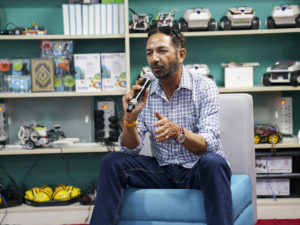 Recently we were honoured to host international cricket umpire Anil Chaudhary who spoke honestly and passionately about the parallels between sports and life. He encouraged students to regularly participate in sports for healthy bodies and routines and to learn key life skills including teamwork and conviction in one’s decisions.
Recently we were honoured to host international cricket umpire Anil Chaudhary who spoke honestly and passionately about the parallels between sports and life. He encouraged students to regularly participate in sports for healthy bodies and routines and to learn key life skills including teamwork and conviction in one’s decisions.
This got me thinking if we are doing enough to reward and recognise the value of Physical Education beyond just physical skills.
As a specialist educator, I have always known that the physical education curriculum plays a huge role in the development of the ‘whole child’. But do all stakeholders see this value so clearly?
Physical advantages of young people being involved in sport include:
- Reduced risk of obesity
- Increased cardiovascular fitness
- Improved motor skills including agility, coordination and balance
- Improved sleep
- Mood regulation through endorphins
- A reduction in the time spent on sedentary activities including screen time.
Sport and physical activity provide so much more, and this must be highlighted. It is important that children see the purpose and value of their learning journey beyond a collection of physical skills. Of course, the key aim is to develop and instill positive relationships with physical activity for life (which is even more crucial post the pandemic).
It is essential that everyone is physically literate, but what does a physically literate young person look like and why is it important?

The Definition of Physical Literacy
‘Physical literacy is the motivation, confidence, physical competence, knowledge, and understanding to value and take responsibility for engagement in physical activities for life.’
– The International Physical Literacy Association, May 2014
Physical literacy goes beyond the physical development and competence of a young person. It builds upon their social, emotional and cognitive development. Physical activity and sports help children to cope better with adversity and to build resilience.
It provides opportunities to develop the skills that they need in life, especially empathy and communication. These key life skills have become increasingly important in an ever-changing world, but do children link these skills to physical activity?
 Learning the different dimensions of leadership at an early age is important, and knowing it is about what you do and how you affect those around you is vital. Having the skills to be the driving force for change and positivity from a range of positions can encourage cooperation and teamwork – an integral attribute for any sports team, choir, playground game or office.
Learning the different dimensions of leadership at an early age is important, and knowing it is about what you do and how you affect those around you is vital. Having the skills to be the driving force for change and positivity from a range of positions can encourage cooperation and teamwork – an integral attribute for any sports team, choir, playground game or office.
Respect and fairness, empathy and gratitude, courage and resilience – all can be experienced through sport and physical activity. It is our collective responsibility to build a solid foundation and partnership of emotional, cognitive, physical and social development to ensure that we instill these important set of values in our children.
Just like a school runs on its values and visions, sports too require a set of values that supports a holistic moral compass to empower our children to be successful 21st century citizens.
References
- https://www.youthsporttrust.org/my-personal-best
- Physical Literacy diagram: Author unknown

